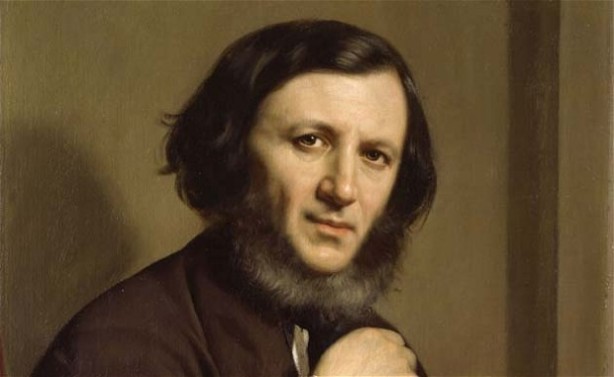Room 24: Robert Browning
There are only two words that spring to mind whenever I am confronted with this portrait of Robert Browning: Neck and Beard. Now the nineteenth-century is generally considered a pretty good time to be a snappy dresser. Beau Brummel had given the world the trouser and a healthy respect for sharp tailoring (before taking himself off to expire of syphilis in a French lunatic asylum – such was the wont of the finest of Regency celebrities.) In our own age, between hipster moustaches and Steampunk greatcoats, there’s still a lot of love for some of the great Victorian sartorial staples. But when it comes to the neck beard, I think I speak for the majority when I say ‘KILL IT WITH FIRE!’
Questionable neck-fuzz aside, however, Browning had rather a lot going for him. As a young man he managed to win the affections of the far more successful poetess Elizabeth Barrett and their early correspondence is available via the Browning Correspondence project. Elizabeth’s father disapproved of the match and (whilst I have been unable to find solid evidence of this in the correspondence) I’m quite sure the creepy neck-fuzz had something to do with it. The couple married and lived in Italy until Elizabeth’s death in 1861.
As a poet, Browning is best known for his pioneering use of the dramatic monologue form, and for such works as ‘Porphyria’s Lover’, ‘My Last Duchess’ and ‘Andrea del Sarto’. He’s one of those poets who always feels wonderfully unvictorian – there’s a fantastical, dramatic quality to so many of his poems, and a darkly sinister undercurrent of madness to a lot of his speakers which feel so at odds to the stately meters of someone like Tennyson.
And I can’t mention Browning and Tennyson in the same post without directing you to these glorious recordings, made in 1889 and 1890 on Edison’s Wax Cylinders. In the first, Tennyson reads his much-celebrated poem ‘The Charge of the Light Brigade’ (1854) with all the sombre dignity you might expect from a former poet laureate.
This second recording was made at a dinner party given by the artist Rudolf Lehmann on the 7th April 1889. You can imagine the scene: one of the guests at the party, who just happens to be the sales manager of the Edison Talking Machine company, whips out the company’s newest model and invites guests to record themselves. Browning, who has had a couple of drinks by this point (but has thankfully succumbed to the wisdom of old age and grown out the abominable neckbeard) jumps up and begins to recite verses from ‘How They Brought the Good News from Ghent to Aix’. I’ll let you listen for yourself to what happens next…
Say it with me now….Hip Hip HOORAAAY!

September 29, 2016 at 5:54 pm
“But when it comes to the neck beard, I think I speak for the majority when I say ‘KILL IT WITH FIRE!’” hahahahahaha! No kidding. That thing is awful. It’s like a fake beard that he pulled down to dramatically reveal his true identity or something. Just awful. 😆
LikeLiked by 1 person